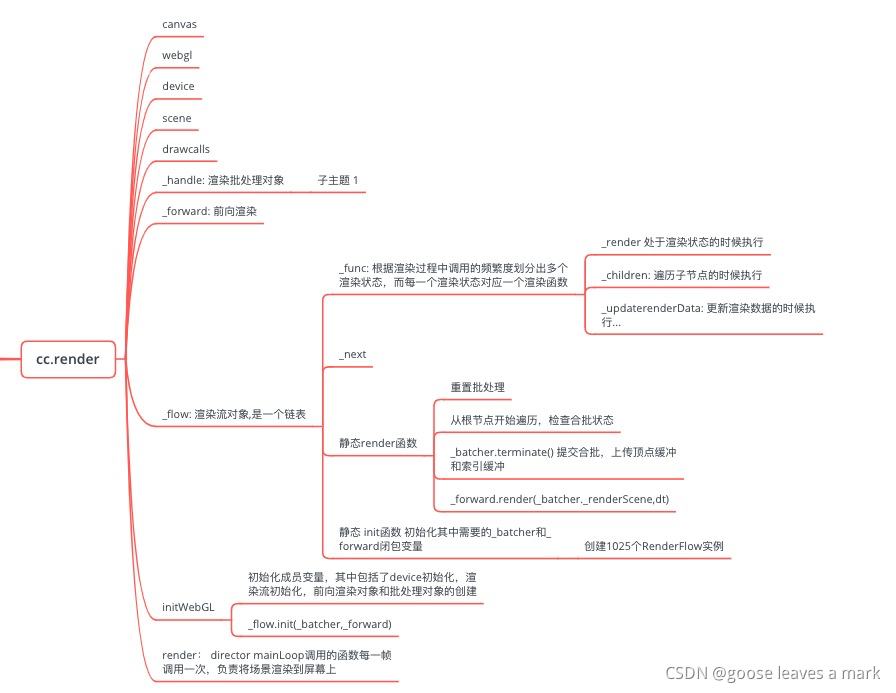一: Render-flow基本构成
从CCDirector.js中的mainLoop我们了解到 renderer.render是实际参与渲染的方法:顺着线索我们找到了RenderFlow这个类:下面是我整理的部分关键的方法和属性:

首先看一下initWebGL方法:
initWebGL (canvas, opts) {
require('./webgl/assemblers');
const ModelBatcher = require('./webgl/model-batcher');
this.Texture2D = gfx.Texture2D;
this.canvas = canvas;
this._flow = cc.RenderFlow;
if (CC_JSB && CC_NATIVERENDERER) {
// native codes will create an instance of Device, so just use the global instance.
this.device = gfx.Device.getInstance();
this.scene = new renderer.Scene();
let builtins = _initBuiltins(this.device);
this._forward = new renderer.ForwardRenderer(this.device, builtins);
let nativeFlow = new renderer.RenderFlow(this.device, this.scene, this._forward);
this._flow.init(nativeFlow);
}
else {
let Scene = require('../../renderer/scene/scene');
let ForwardRenderer = require('../../renderer/renderers/forward-renderer');
this.device = new gfx.Device(canvas, opts);
this.scene = new Scene();
let builtins = _initBuiltins(this.device);
// 前向渲染对象负责将view视图通过device渲染都屏幕上
this._forward = new ForwardRenderer(this.device, builtins);
// 渲染前批处理,优化性能,降低drawcall
this._handle = new ModelBatcher(this.device, this.scene);
// 初始化渲染流对象依赖 前向渲染对象和批处理
this._flow.init(this._handle, this._forward);
console.log(`scene is `,this.scene,' and device is ',this.device,' and _flow is ',this._flow,' and _handle is ',this._handle);
}
},再来看看主角方法render(scene,dt):
render (ecScene, dt) {
/** 重置drawcall */
this.device.resetDrawCalls();
if (ecScene) {
// walk entity component scene to generate models
/** 调用渲染静态函数 */
this._flow.render(ecScene, dt);
this.drawCalls = this.device.getDrawCalls();
}
},继续跟进看看render: 下一节着重看看这个前向渲染 _forward
RenderFlow.render = function (rootNode, dt) {
_batcher.reset();
_batcher.walking = true;
/** 递归遍历根节点 */
RenderFlow.visitRootNode(rootNode);
// 从根节点深度遍历完毕,开始执行批处理
_batcher.terminate();
_batcher.walking = false;
// 将batcher中的渲染数据渲染到屏幕 _forward渲染数据需要用到合批的渲染数据两个类有相互依赖的关系
_forward.render(_batcher._renderScene, dt);
};重点看看批处理的东西:model-batcher.js
terminate() {
if (cc.dynamicAtlasManager && cc.dynamicAtlasManager.enabled) {
cc.dynamicAtlasManager.update();
}
// flush current rest Model
this._flush();
for (let key in _buffers) {
_buffers[key].uploadData();
}
this.walking = false;
},跟踪到此查看_flush()
/***
*
* 强制刷新缓冲区数据
*
*/
_flush() {
let material = this.material,
buffer = this._buffer,
indiceCount = buffer.indiceOffset - buffer.indiceStart;
if (!this.walking || !material || indiceCount <= 0) {
return;
}
let effect = material.effect;
if (!effect) return;
// Generate ia
let ia = this._iaPool.add();
// 顶点数据缓冲区
ia._vertexBuffer = buffer._vb;
// 顶点索引缓冲区
ia._indexBuffer = buffer._ib;
// 顶点索引开始索引
ia._start = buffer.indiceStart;
// 顶点索引个数
ia._count = indiceCount;
// Generate model
let model = this._modelPool.add();
this._batchedModels.push(model);
model.sortKey = this._sortKey++;
model._cullingMask = this.cullingMask;
model.setNode(this.node);
model.setEffect(effect);
model.setInputAssembler(ia);
this._renderScene.addModel(model);
buffer.forwardIndiceStartToOffset();
},关于vb和ib想必大家都知道什么意思,下面看一下一个顶点数据包含哪些数据:
var vfmtPosUvColor = new gfx.VertexFormat([
{ name: gfx.ATTR_POSITION, type: gfx.ATTR_TYPE_FLOAT32, num: 2 },
{ name: gfx.ATTR_UV0, type: gfx.ATTR_TYPE_FLOAT32, num: 2 },
{ name: gfx.ATTR_COLOR, type: gfx.ATTR_TYPE_UINT8, num: 4, normalize: true },
]); 
看看渲染流的init静态方法:
RenderFlow.init = function (batcher, forwardRenderer) {
_batcher = batcher;
_forward = forwardRenderer;
// 这里flows是一个包含了1025个RenderFlow对象,而每一个对象又是一个渲染链表对象
flows[0] = EMPTY_FLOW;
for (let i = 1; i < FINAL; i++) {
flows[i] = new RenderFlow();
}
};看看init方法:渲染流真正执行_func的时候会调用它,是根据节点的渲染标识进行创建的
function init (node) {
// 拿到节点的渲染标识
let flag = node._renderFlag;
// 根据节点身上的渲染标识进行创建渲染流
let r = flows[flag] = getFlow(flag);
// 执行对应的渲染流函数
r._func(node);
}看看getFlow函数,就是在这里创建了渲染流链表:
function getFlow (flag) {
let flow = null;
let tFlag = FINAL;
while (tFlag > 0) {
if (tFlag & flag)
// 创建渲染流 将上一个flow传入构成一个链
flow = createFlow(tFlag, flow);
tFlag = tFlag >> 1;
}
return flow;
}每一次createFlow都会将当前的flow置为头节点
function createFlow (flag, next) {
let flow = new RenderFlow();
// 将当前创建的渲染流置于链表的头部
flow._next = next || EMPTY_FLOW;
switch (flag) {
case DONOTHING:
flow._func = flow._doNothing;
break;
case BREAK_FLOW:
flow._func = flow._doNothing;
break;
case LOCAL_TRANSFORM:
flow._func = flow._localTransform;
break;
case WORLD_TRANSFORM:
flow._func = flow._worldTransform;
break;
case OPACITY:
flow._func = flow._opacity;
break;
case COLOR:
flow._func = flow._color;
break;
case UPDATE_RENDER_DATA:
flow._func = flow._updateRenderData;
break;
case RENDER:
flow._func = flow._render;
break;
case CHILDREN:
flow._func = flow._children;
break;
case POST_RENDER:
flow._func = flow._postRender;
break;
}
return flow;
}二:节点渲染顺序是怎样的
节点在渲染的时候的渲染顺序在CCNode.js文件里面 源码如下:
_onBatchCreated(dontSyncChildPrefab) {
this._initProperties();
// Fixed a bug where children and parent node groups were forced to synchronize, instead of only synchronizing `_cullingMask` value
this._cullingMask = 1 << _getActualGroupIndex(this);
if (CC_JSB && CC_NATIVERENDERER) {
this._proxy && this._proxy.updateCullingMask();
}
if (!this._activeInHierarchy) {
if (CC_EDITOR ? cc.director.getActionManager() : ActionManagerExist) {
// deactivate ActionManager and EventManager by default
cc.director.getActionManager().pauseTarget(this);
}
eventManager.pauseTarget(this);
}
let children = this._children;
// 采用深度遍历的方式遍历子节点最后才是根节点
for (let i = 0, len = children.length; i < len; i++) {
let child = children[i];
if (!dontSyncChildPrefab) {
// sync child prefab
let prefabInfo = child._prefab;
if (prefabInfo && prefabInfo.sync && prefabInfo.root === child) {
PrefabHelper.syncWithPrefab(child);
}
child._updateOrderOfArrival();
}
child._onBatchCreated(dontSyncChildPrefab);
}
if (children.length > 0) {
// 如果该节点有子节点就加一个渲染标记
this._renderFlag |= RenderFlow.FLAG_CHILDREN;
}
if (CC_JSB && CC_NATIVERENDERER) {
this._proxy.initNative();
}
},我们可以清楚的看到节点遍历方式是深度遍历的方式。
这时候你应该会问这个方法在哪里调用呢:主要是两个地方调用:CCScene.js,base-node.js
CCScene.js: 这个是在编辑器环境下生效
_load: function () {
if (!this._inited) {
if (CC_TEST) {
cc.assert(!this._activeInHierarchy, 'Should deactivate ActionManager and EventManager by default');
}
this._onBatchCreated(CC_EDITOR && this._prefabSyncedInLiveReload);
this._inited = true;
}
},base-node.js:
_instantiate (cloned, isSyncedNode) {
if (!cloned) {
cloned = cc.instantiate._clone(this, this);
}
var newPrefabInfo = cloned._prefab;
if (CC_EDITOR && newPrefabInfo) {
if (cloned === newPrefabInfo.root) {
newPrefabInfo.fileId = '';
}
else {
var PrefabUtils = Editor.require('scene://utils/prefab');
PrefabUtils.unlinkPrefab(cloned);
}
}
if (CC_EDITOR && cc.engine._isPlaying) {
let syncing = newPrefabInfo && cloned === newPrefabInfo.root && newPrefabInfo.sync;
if (!syncing) {
cloned._name += ' (Clone)';
}
}
// reset and init
cloned._parent = null;
cloned._onBatchCreated(isSyncedNode);
return cloned;
},





















 737
737











 被折叠的 条评论
为什么被折叠?
被折叠的 条评论
为什么被折叠?








